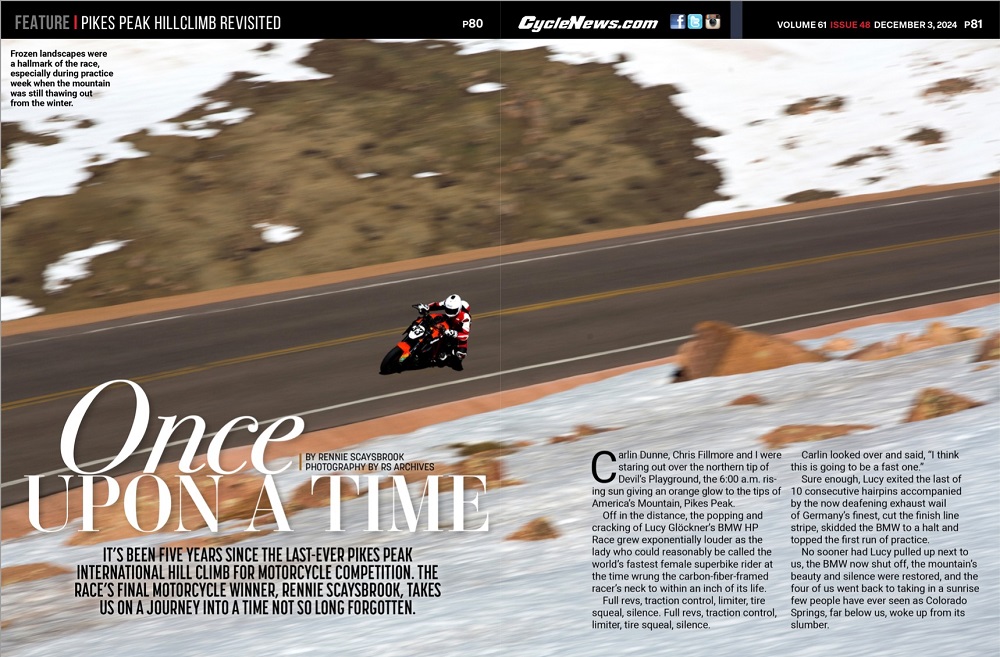Rennie Scaysbrook | December 8, 2024
It’s been five years since the last-ever Pikes Peak International Hill Climb for motorcycle competition. The race’s final motorcycle winner, Rennie Scaysbrook, takes us on a journey into a time not so long forgotten.
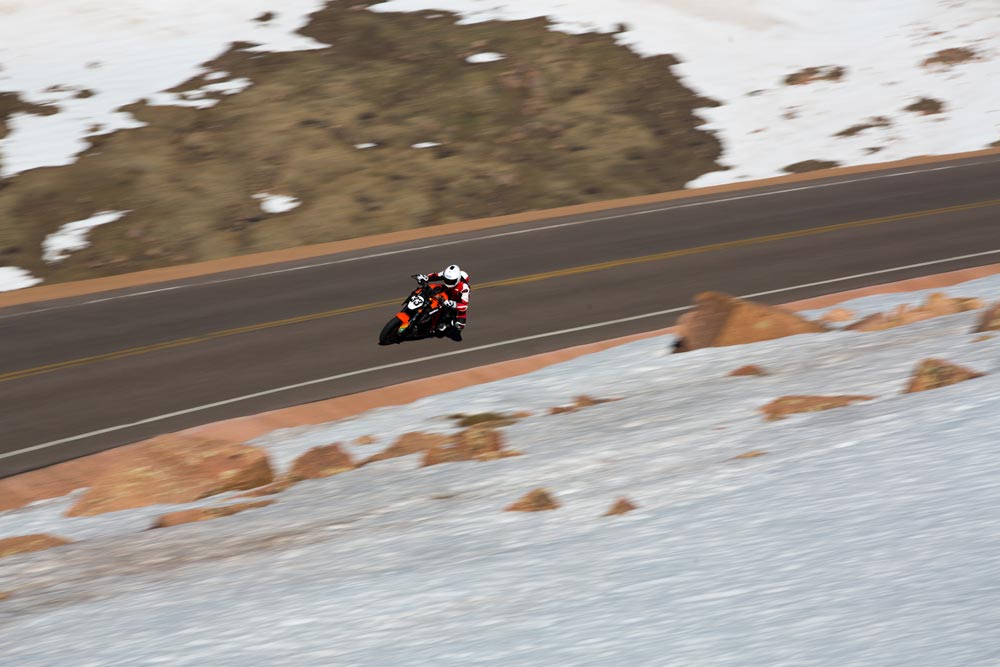 Frozen landscapes were a hallmark of the race, especially during practice week when the mountain was still thawing out from winter.
Frozen landscapes were a hallmark of the race, especially during practice week when the mountain was still thawing out from winter.
Photography by RS Archives
Carlin Dunne, Chris Fillmore and I were staring out over the northern tip of Devil’s Playground, the 6:00 a.m. rising sun giving an orange glow to the tips of America’s Mountain, Pikes Peak.
Off in the distance, the popping and cracking of Lucy Glöckner’s BMW HP Race grew exponentially louder as the lady who could reasonably be called the world’s fastest female superbike rider at the time wrung the carbon-fiber-framed racer’s neck to within an inch of its life.
Full revs, traction control, limiter, tire squeal, silence. Full revs, traction control, limiter, tire squeal, silence.
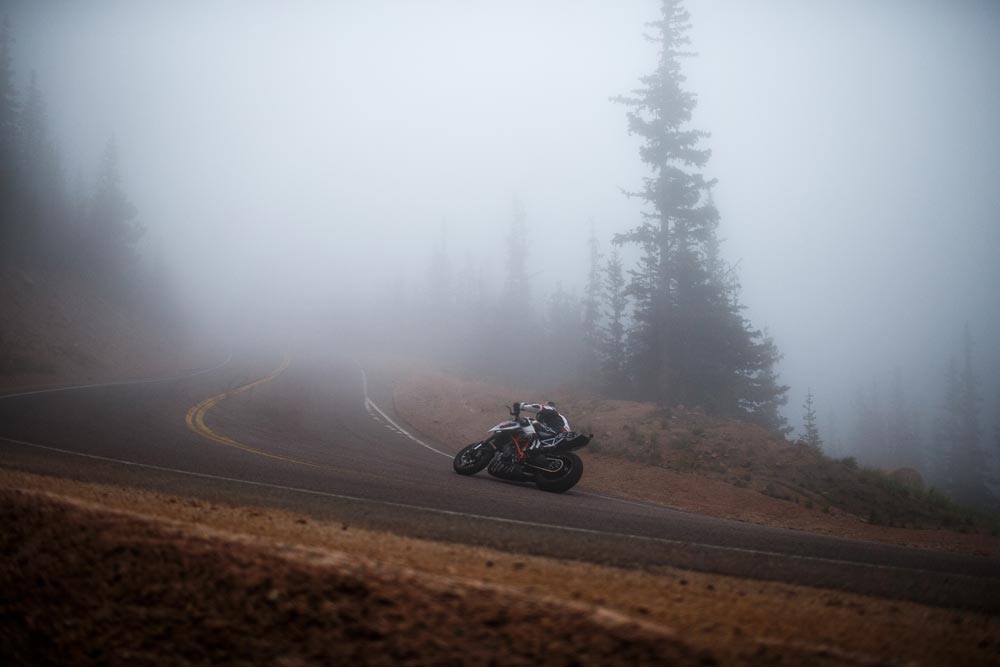 The fog was so bad in 2017, qualifying day, the riders could hardly see 10 meters in front of the bikes, yet the session still ran.
The fog was so bad in 2017, qualifying day, the riders could hardly see 10 meters in front of the bikes, yet the session still ran.
Carlin looked over and said, “I think this is going to be a fast one.”
Sure enough, Lucy exited the last of 10 consecutive hairpins accompanied by the now deafening exhaust wail of Germany’s finest, cut the finish line stripe, skidded the BMW to a halt and topped the first run of practice.
No sooner had Lucy pulled up next to us, the BMW now shut off, the mountain’s beauty and silence were restored, and the four of us went back to taking in a sunrise few people have ever seen as Colorado Springs, far below us, woke up from its slumber.
It’s one of my outstanding memories of four years racing America’s last great road race.
Three days later, Carlin Dunne died in a last-corner accident when he was on course to not just beat my new course record but smash it.
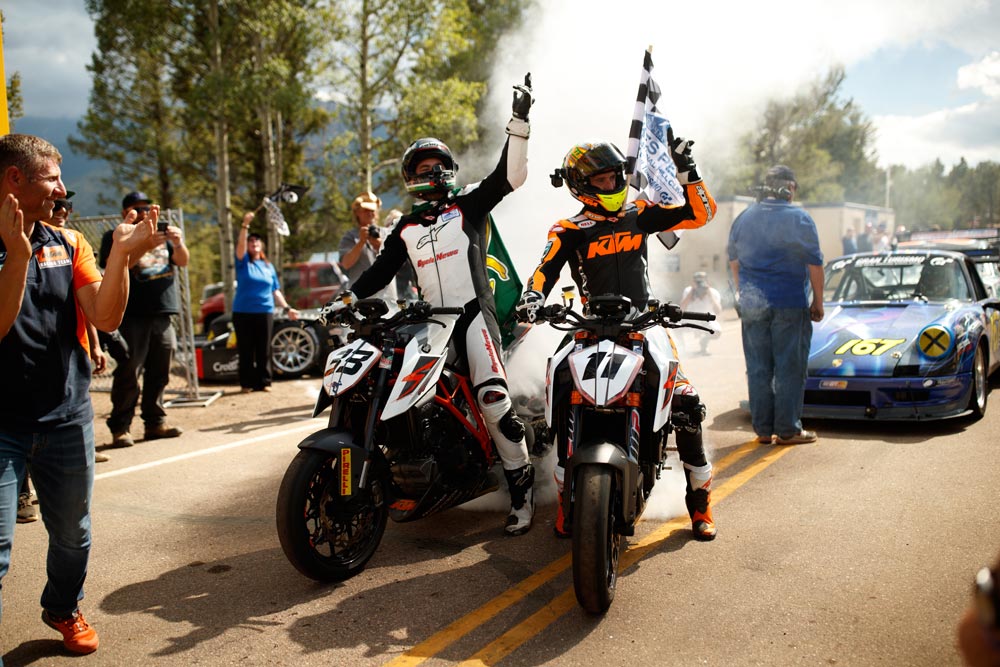 Chris Fillmore (11) celebrates with teammate Scaysbrook (33) after the pair went 1-2 in a record-breaking 2017 race.
Chris Fillmore (11) celebrates with teammate Scaysbrook (33) after the pair went 1-2 in a record-breaking 2017 race.
Carlin was absolutely the man at Pikes Peak. I’ve never seen a rider so perfectly attuned to one racing venue, save for perhaps Michael Dunlop and the TT Mountain Course. Dunne’s death marked the permanent end of motorcycle competition at the Pikes Peak International Hill Climb, a discipline that can trace its beginning way back to 1916, one year after the start of World War I.
Bikes have always had a tenuous relationship with America’s Mountain, and, unlike the cars, had not run every year the classic hill climb event was staged. Indeed, its 156 turns and 12.42 miles have only seen motorcycles compete 41 times.
 Fillmore’s prowess of the mountain was absolute. His victory in the Lightweight category in 2019 meant he never lost a race in three attempts at Pikes Peak.
Fillmore’s prowess of the mountain was absolute. His victory in the Lightweight category in 2019 meant he never lost a race in three attempts at Pikes Peak.
Until 1991, the race was not a time trial but a mass start, hordes of madcap racers roaring off on the dirt road all at once to see who would win The Race to The Clouds. The Isle of Man TT learned its lesson with mass starts in the 1960s, but Pikes was determined to be different.
Floyd Clymer was the first rider to take the gold at Pikes (while the road to the summit was still under construction, no less), his winning time a touch under the 22-minute mark. This was about a century after Lt. Zebulon Pike declared, falsely, that no man would ever be able to reach the top of the 14,000-foot-tall mountain.
 Scaysbrook and Ducati’s Carlin Dunne wish each other good luck as the last two riders ready to take on the mountain in 2019. Tragically, only Scaysbrook would make it to the top.
Scaysbrook and Ducati’s Carlin Dunne wish each other good luck as the last two riders ready to take on the mountain in 2019. Tragically, only Scaysbrook would make it to the top.
Following the outbreak of World War I, no race was staged. When the race was again given the green light in 1920, motorcycles were scratched from the program due to the race not being sanctioned by the American Motorcyclist Association. It would remain this way for the next 34 years.
It didn’t get much better, as bikes were only to see the checkered flag for two more years in 1954 and 1955, before being put on hiatus again until 1971. A near catastrophic accident in 1976, in which one of the two racers contending for victory at the Peak’s summit collided with the pole supporting the finish line banner, caused the wire holding the banner to fall and stretch across the road, nearly decapitating the third-place racer as he approached.
 Racers line up, ready for the mass start in 1954. By 1991, saner heads prevailed, and the race was turned into a time trial.
Racers line up, ready for the mass start in 1954. By 1991, saner heads prevailed, and the race was turned into a time trial.
Yet more halting of motorcycle competition would follow, this gap stretching from 1976 to 1980. Two more years of racing were met with the death of competitor Bill Gross in 1982 and another elimination of the motorcycle program until 1991.The return of motorcycle racing to Pikes Peak brought with it a change of format, one where the riders were timed in the traditional hill climb style rather than being a banzai mass start.The 1991 return heralded the golden era for bike competition at Pikes Peak, the race running uninterrupted for the next 28 years. But it was in 2012 that the race began to take off.
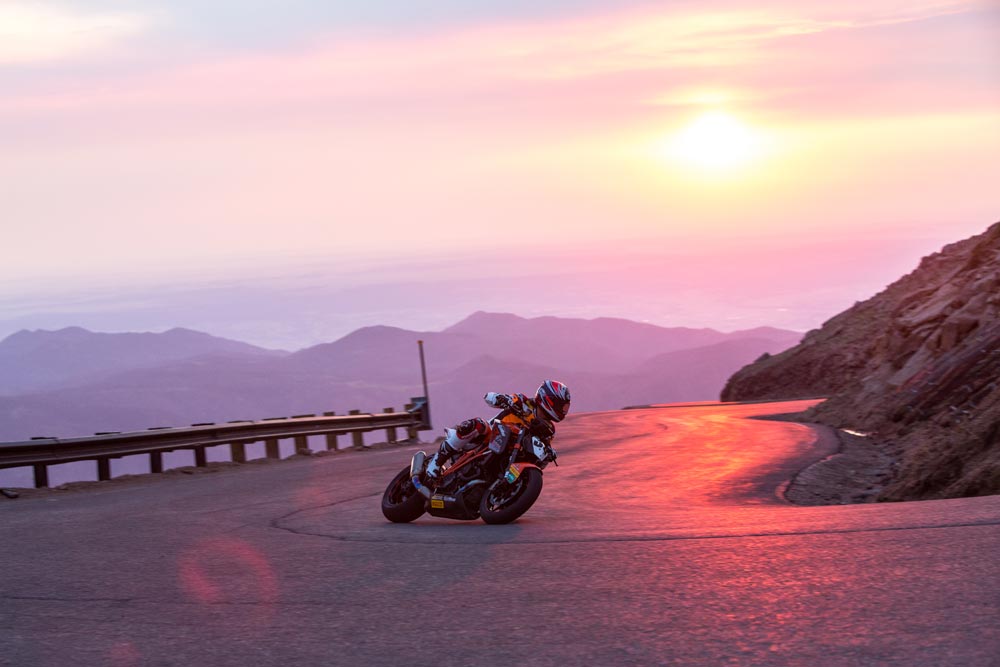 The early morning sun watches over Rennie during practice for the 2016 Pikes Peak International Hill Climb. No where on earth could you get racing vistas like this.
The early morning sun watches over Rennie during practice for the 2016 Pikes Peak International Hill Climb. No where on earth could you get racing vistas like this.
Due to pressure from the increasing number of tourists visiting the mountain (an average of over 22 million visit the mountain each year, making Pikes Peak the number one—by far—tourist attraction in Colorado Springs), the local council paved the road all the way to the summit, and as speeds went up, records immediately fell. Here we meet Mr. Dunne and the company he is synonymous with, Ducati.
Carlin was already a winner of The Race To The Clouds in 2011 when he piloted a Ducati Multistrada to victory while the track was a hybrid of half dirt, half tarmac. From 2011 to 2013, Carlin remained undefeated, taking the course record on full tarmac in 2012 at 9:52.819 from factory Ducati teammate and former race winner Greg Tracy. They were the first riders to break the mythical 10-minute barrier. Ducati decided to commemorate this occasion by creating the Multistrada Pikes Peak, a model that continues to this day.
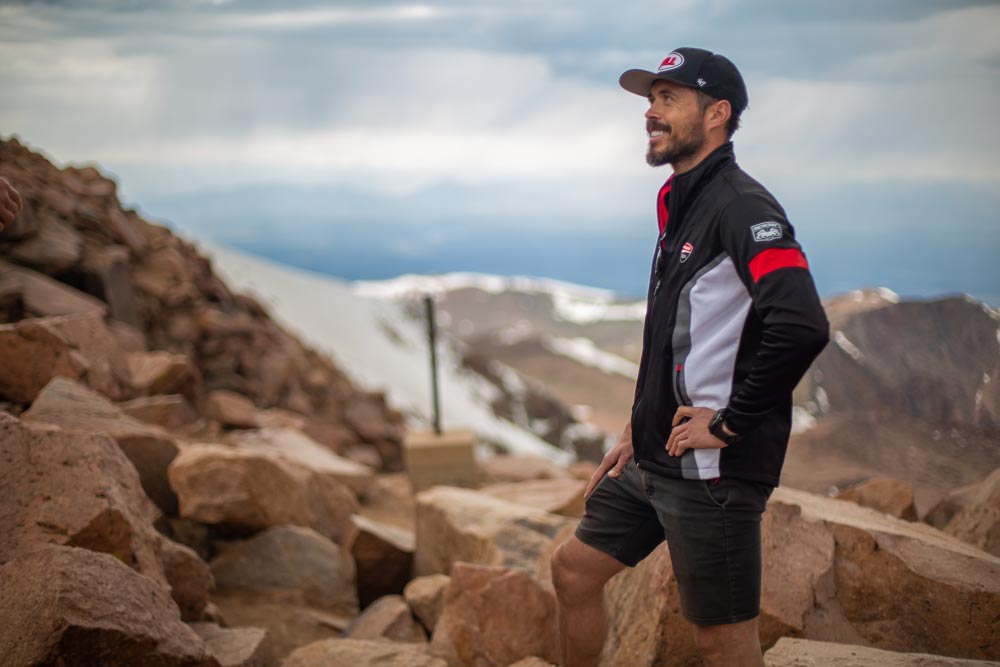 Dunne poses during the 2019 media event for the race.
Dunne poses during the 2019 media event for the race.
Carlin shook up the establishment still further in 2013, when he joined fledgling electric motorcycle company Lightning and rode the exotic LS218 to the only overall victory for a non-internal combustion engine motorcycle, falling just shy of the 10-minute mark with his time of 10:00.694. Dunne then promptly hung up his helmet from racing at Pikes Peak, but, as we now know, that wouldn’t last.
The full paving of the road brought with it new bikes and new riders as the race began to draw interest from manufacturers other than Ducati. Leading U.S. rider Jeremy Toye, a Macau Grand Prix podium finisher and Isle of Man TT racer, lifted the laurels in 2014 on a Kawasaki ZX-10R, and AMA Supersport star Jeffrey Tigert used a Honda CBR1000RR to win in 2015. This, as it turned out, would be the last win for a “traditional” four-cylinder superbike, as yet more tragedy would befall the race.
 Dunne during his first win in 2011 when the race was run on a half tarmac, half dirt hybrid circuit.
Dunne during his first win in 2011 when the race was run on a half tarmac, half dirt hybrid circuit.
Following the death of Bobby Goodin in 2014, who lost control of his Triumph Daytona 675 after he crossed the finish line and slammed into the boulders that adorn the mountain’s peak, Carl Sorensen passed away when he crashed his Kawasaki ZX-10R on the descent from Devil’s Playground into the daunting section of track dubbed Bottomless Pit in practice.
Faced with banning the bikes once and for all or changing the rules, race organizers then implemented a rather strange regulation that stated every motorcycle that could be entered to race had to come with a one-piece handlebar as standard from the manufacturer, effectively ruling out superbikes and allowing only naked bikes to compete.
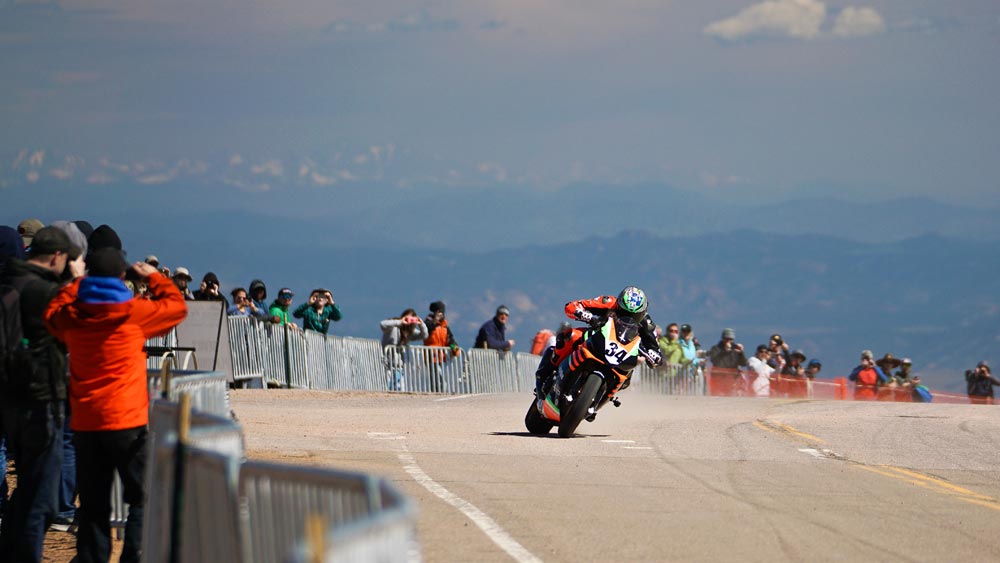 Scaysbrook lights up the Aprilia on the run out of Devil’s Playground as he heads to Bottomless Pit during his 2019 record-breaking ride.
Scaysbrook lights up the Aprilia on the run out of Devil’s Playground as he heads to Bottomless Pit during his 2019 record-breaking ride.
However, a separate class was created called Exhibition Powersport that allowed the use of such machines as Glöckner’s aforementioned BMW HP Race and Dunne’s Streetfighter V4—as long as they were modified to run a naked bike-style one-piece handlebar. These machines would not be eligible for prize money and the King of The Mountain title but were eligible for all course records.
No one took this offer up until that fateful 2019 race, and between 2016-2018, several new entries that included factory-backed Ducati, KTM, BMW and Aprilia all decided to compete.
 5:30 am and Scaysbrook’s Super Duke is registering with the little “cold” symbol on the bottom left of the dash during practice in 2016. Perfect Austrian humor if we ever see it.
5:30 am and Scaysbrook’s Super Duke is registering with the little “cold” symbol on the bottom left of the dash during practice in 2016. Perfect Austrian humor if we ever see it.
The 2016 year was my first attempt at the race, when I built up a KTM 1290 Super Duke R and, with the support of KTM USA and Pirelli, finished second to Frenchman Bruno Langlois on a Kawasaki Z1000.
In 2017, I was back, this time in the full factory KTM team, where my rookie teammate, AMA Superbike and Supermoto gun Chris Fillmore, took a spectacular win and course record of 9:49.625 with me again in second place. It was the happiest I’ve ever been to finish second and heralded a historic moment for KTM Factory Racing.
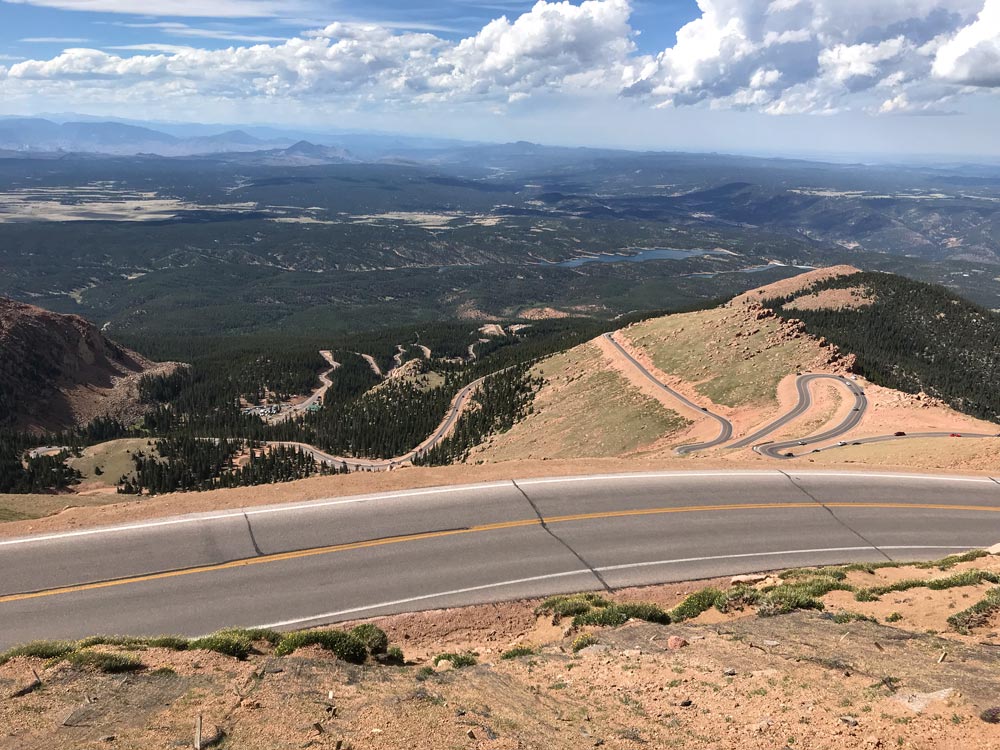 The mountain in all her beauty. When the sun shone, and no one else was on the road, it was a hell of a place to ride a fast motorcycle.
The mountain in all her beauty. When the sun shone, and no one else was on the road, it was a hell of a place to ride a fast motorcycle.
By now, Pikes Peak was really starting to gain notoriety—the good kind. Chris’ win in 2017 was the first from a truly internationally recognized racer and gave the event a level of credibility that until that point seemed out of reach.
At this point, Carlin Dunne’s itch to compete once more couldn’t be ignored, and he fronted up for the 2018 race with full factory Ducati support alongside teammate Codie Vahsholtz.
I was once again back with KTM, determined to make it a third time’s a charm win. I came within six-tenths of a second of Dunne. If 2017 was the happiest I’d been to finish second, 2018 was by far the worst.
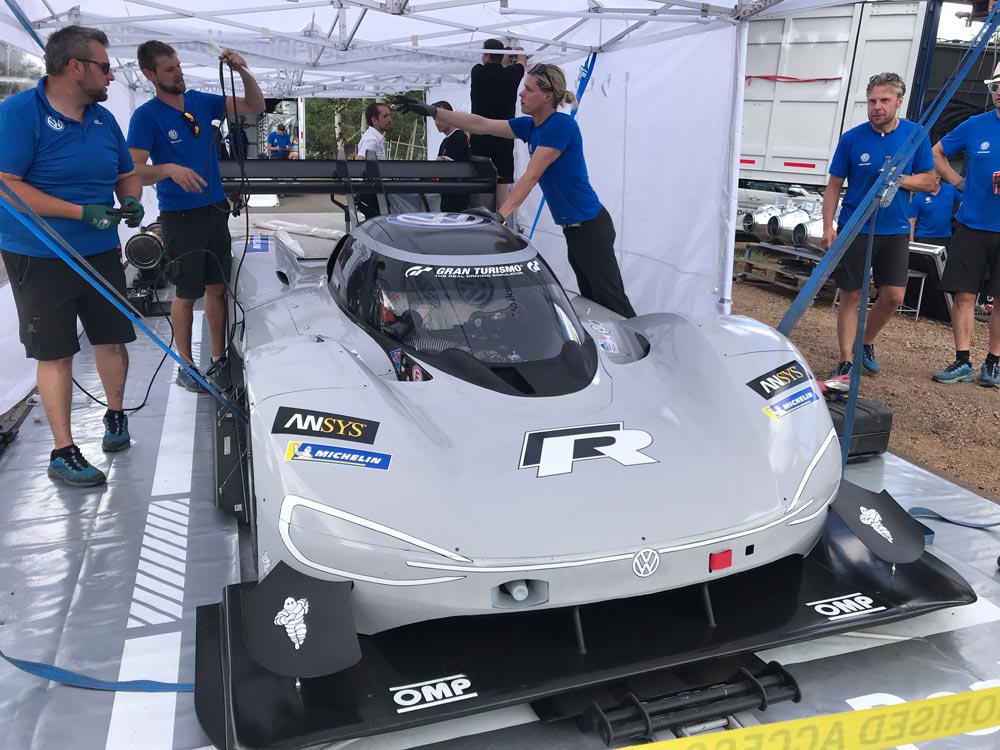 The incredible Volkswagen I.D. R prototype electric racecar of Frenchman Romain Dumas of 2018. This car still holds the all-time course record at a mind-warping 8:57.118.
The incredible Volkswagen I.D. R prototype electric racecar of Frenchman Romain Dumas of 2018. This car still holds the all-time course record at a mind-warping 8:57.118.
It was the closest winning margin of any class—bike, car, sidecar, whatever—in the race’s history.
I returned in 2019, this time with the factory Aprilia USA squad on a Tuono V4 Factory in the Heavyweight division. Carlin was back, this time on a prototype Ducati Streetfighter V4 that was really a very trick Panigale V4 S with high ’bars fitted in the Exhibition Powersport class.
 Scaysbrook lays it all on the line during practice in the notorious middle section of the track.
Scaysbrook lays it all on the line during practice in the notorious middle section of the track.
Joining him was Glöckner on the BMW HP Race and Michael Dunlop had signed up to race a BMW S 1000 R, meaning this was the most stacked field in living memory at Pikes Peak. Chris Fillmore was there as well, but he raced a 450cc KTM supermoto in the Lightweight division after claiming the Middleweight victory in 2018 on a KTM 790 Duke.
After swapping fastest times between myself, Glöckner and Dunne, Dunne simply rode away from everyone in the race proper. I qualified second fastest, and my run of 9:44.963 was probably the best I’ve ever ridden a motorcycle, but it wasn’t going to be enough to defeat the best rider ever to grace the mountain in Carlin Dunne.
 Scaysbrook crosses the line as the winner in 2019. His Aprilia Tuono V4 Factory would be the last motorcycle ever to see the Pikes Peak checkered flag.
Scaysbrook crosses the line as the winner in 2019. His Aprilia Tuono V4 Factory would be the last motorcycle ever to see the Pikes Peak checkered flag.
Carlin crashed on the last of 156 corners, within sight of the checkered flag. The record was comfortably his, until it wasn’t. And with his death came the end of one of the most incredible two-wheel racing events the world had ever seen.
I am thus the last winner of a motorcycle race at Pikes Peak, but, in truth, no one won that day. There were only losers.
 The feeling of four years of hard work finally paying off sinks in for Scaysbrook, but, unbeknownst to him and everybody celebrating, Dunne had just lost his life a mere 30 meters away.
The feeling of four years of hard work finally paying off sinks in for Scaysbrook, but, unbeknownst to him and everybody celebrating, Dunne had just lost his life a mere 30 meters away.
You had to pinch yourself occasionally at Pikes Peak. This fantasy of a racetrack that snaked up America’s Mountain was normally reserved for grandparents and their huge motorhomes as they trudged their way up the hill, admiring the bighorn sheep, mountain goats and the gophers that were a constant hazard to the racers.
But when the weather was good, you had some soft compound Pirellis straight off the warmers and no one but you on the road, it felt like you were in a video game. Nowhere on Earth could you get the thrill of Pikes Peak. It was entirely unique and very different than somewhere like the TT Mountain Course because the fact you were going up a very steep mountain gave most of the corners a fairly pronounced positive camber, so you could—as long as you had the stones—absolutely throw your bike into the corner almost like a motocrosser does a berm.
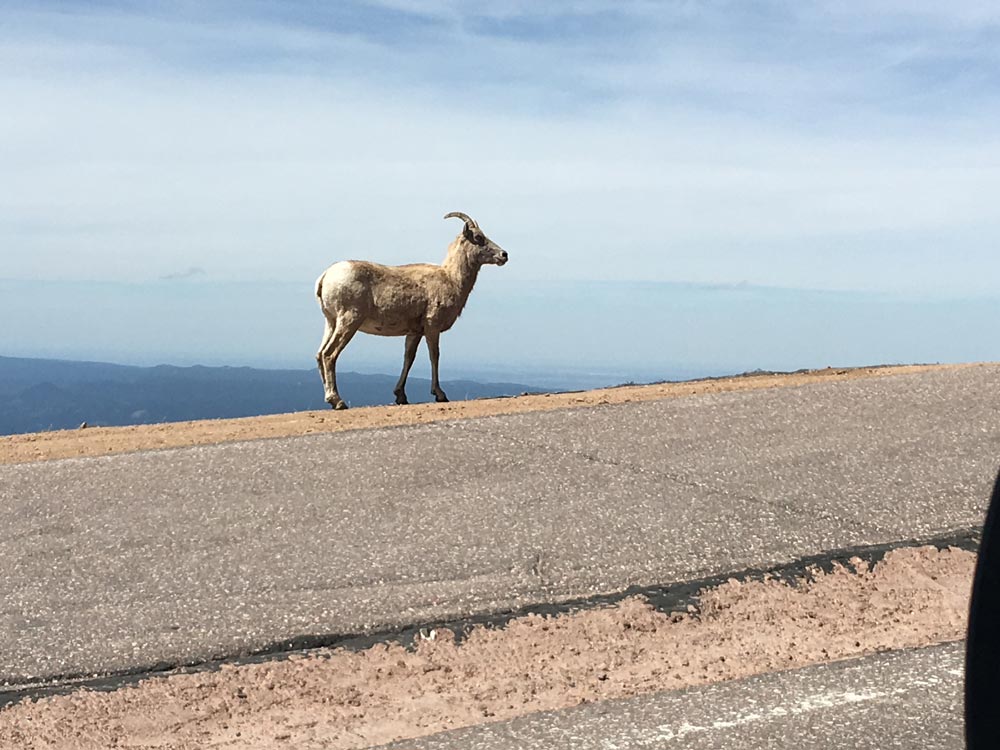 Mountain goats, bighorn sheep, deer and gophers were a constant threat to the racers, but nothing could be done about it.
Mountain goats, bighorn sheep, deer and gophers were a constant threat to the racers, but nothing could be done about it.
The course was broken up into three sections—the first, from the start line to Glen Cove, suited the traditional circuit road racer, with every number of corner you could think of and billiard-smooth pavement on which to maximize turn speed and to get on the gas as hard as you dared.
The middle section, consisting of 10 hairpins one after the other from Glen Cove to Devil’s Playground, suited the drag racers, as you’d get around each dead slow corner, fire it to the next and repeat. This was the section in which Dunne was near unbeatable.
 Like Fillmore, Dunne was a master of the mountain, the Californian winning on every attempt to finish with an unmatched tally of four wins.
Like Fillmore, Dunne was a master of the mountain, the Californian winning on every attempt to finish with an unmatched tally of four wins.
And the final section, from Devil’s Playground to The Summit, was all about eye-watering speed. How bad do you want it? How hard are you prepared to push it? Every corner at Pikes Peak can kill you, but none put the fear into you like the last third of the track. The joke was if you went off the mountain, you’d die of starvation before they found you.
By this stage, you’re over 13,000 feet high, the engine is gasping for oxygen (just like the rider), and the altitude is delaminating your tires. Ever taken a bottle of water onto a plane and seen how it squishes in on itself the higher you go? That’s what happens to your tires at Pikes Peak.
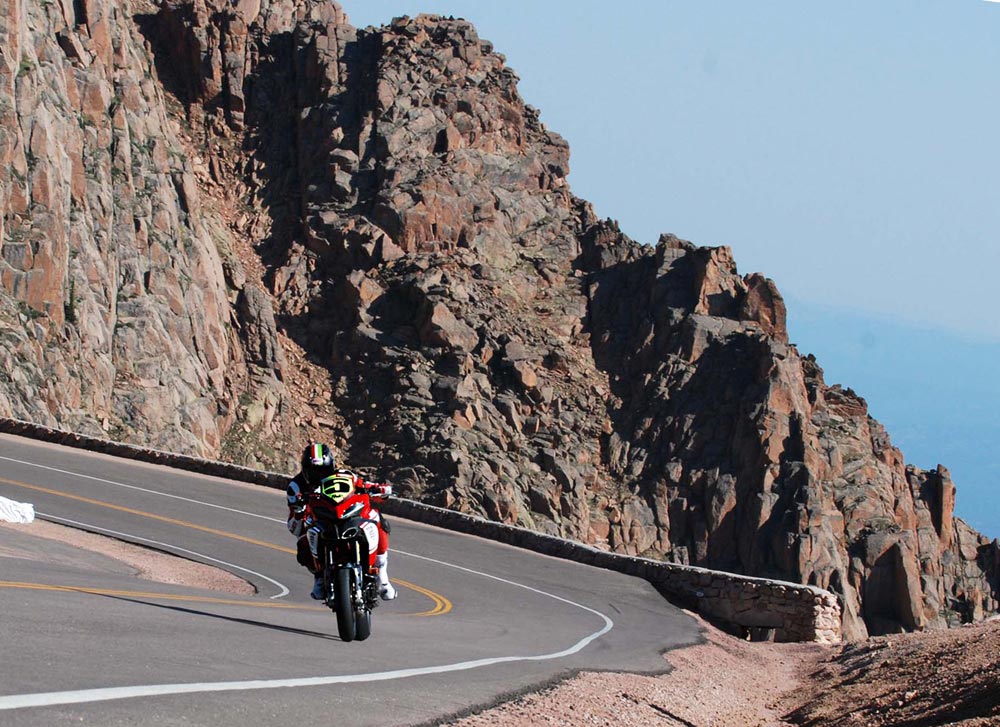 Dunne charges out of Bottomless Pit during his race-winning run in 2012.
Dunne charges out of Bottomless Pit during his race-winning run in 2012.
To get to the top, you know you’ve done something very few people in this world have done. And that is an incredible feeling.
Pikes Peak will always have a special place in American motorcycle racing, but its time is most certainly done. It will never again see a rider take the checkered flag, there will never be another celebratory burnout, and there will never be another rider popping the cork on a winner’s champagne.
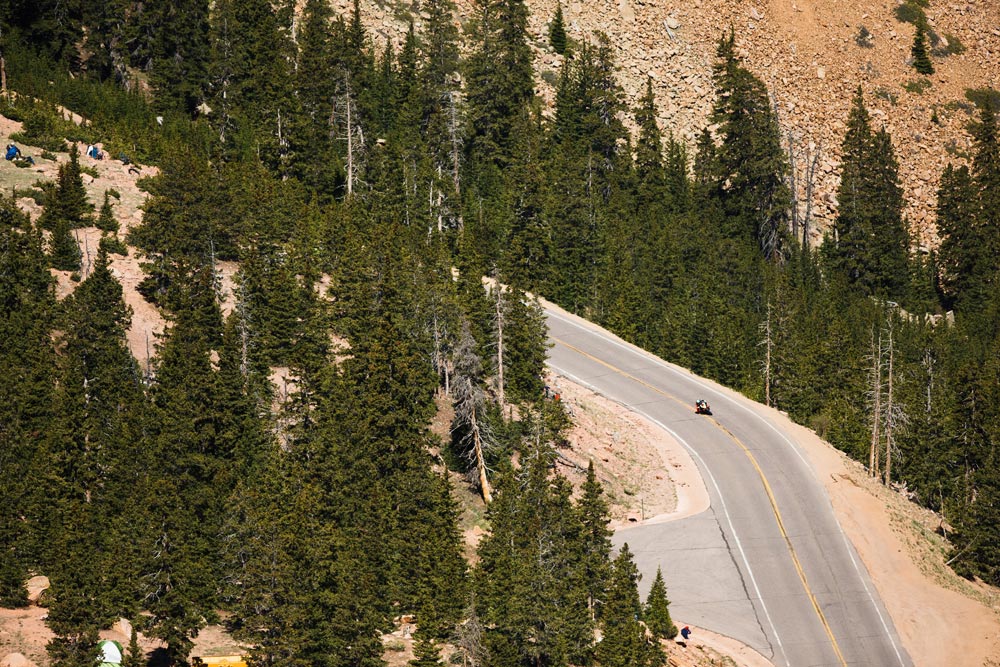 The run up to Elk Park signals the start of the second section of track as Scaysbrook wrings everything out of the Aprilia in 2019.
The run up to Elk Park signals the start of the second section of track as Scaysbrook wrings everything out of the Aprilia in 2019.
It’s easy to be sad it’s over. Carlin Dunne loved the mountain like no other, and I know he would have been mortified that his death caused the end of an event his name was synonymous with.
A better way to look at the Pikes Peak International Hill Climb is to not be sad it’s over but to be happy it happened. CN
